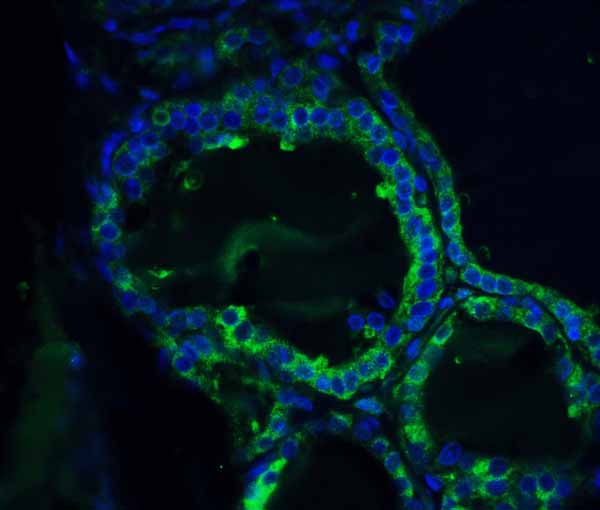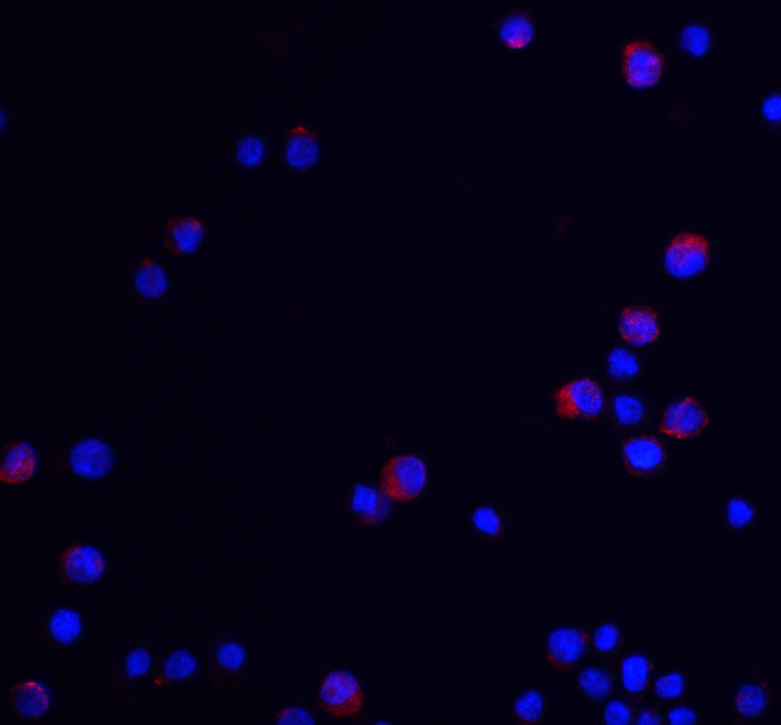DR3 Antibody
- SPECIFICATION
- CITATIONS
- PROTOCOLS
- BACKGROUND

Application
| WB, E |
|---|---|
| Primary Accession | Q93038 |
| Other Accession | AAQ88676, 8718 |
| Reactivity | Human, Mouse |
| Host | Rabbit |
| Clonality | Polyclonal |
| Isotype | IgG |
| Calculated MW | 59 kDa |
| Application Notes | DR3 antibody can be used for detection of DR3 by Western blot 1 μg/mL. A 59 kDa band can be detected. |
| Gene ID | 8718 |
|---|---|
| Other Names | DR3 Antibody: DR3, TR3, DDR3, LARD, APO-3, TRAMP, WSL-1, WSL-LR, TNFRSF12, APO3, DR3, WSL, WSL1, UNQ455/PRO779, Tumor necrosis factor receptor superfamily member 25, Apo-3, tumor necrosis factor receptor superfamily, member 25 |
| Target/Specificity | DR3 antibody was raised against a 16 amino acid peptide near the amino terminus of human DR3. The immunogen is located within the first 50 amino acids of DR3. |
| Reconstitution & Storage | DR3 antibody can be stored at 4℃ for three months and -20℃, stable for up to one year. As with all antibodies care should be taken to avoid repeated freeze thaw cycles. Antibodies should not be exposed to prolonged high temperatures. |
| Precautions | DR3 Antibody is for research use only and not for use in diagnostic or therapeutic procedures. |
| Name | TNFRSF25 |
|---|---|
| Synonyms | APO3, DDR3, DR3, TNFRSF12, WSL, WSL1 |
| Function | Receptor for TNFSF12/APO3L/TWEAK. Interacts directly with the adapter TRADD. Mediates activation of NF-kappa-B and induces apoptosis. May play a role in regulating lymphocyte homeostasis. |
| Cellular Location | [Isoform 1]: Cell membrane; Single-pass type I membrane protein [Isoform 9]: Cell membrane; Single-pass type I membrane protein [Isoform 3]: Secreted. [Isoform 5]: Secreted. [Isoform 7]: Secreted. [Isoform 10]: Secreted. |
| Tissue Location | Abundantly expressed in thymocytes and lymphocytes. Detected in lymphocyte-rich tissues such as thymus, colon, intestine, and spleen. Also found in the prostate |

Thousands of laboratories across the world have published research that depended on the performance of antibodies from Abcepta to advance their research. Check out links to articles that cite our products in major peer-reviewed journals, organized by research category.
info@abcepta.com, and receive a free "I Love Antibodies" mug.
Provided below are standard protocols that you may find useful for product applications.
Background
DR3 Antibody: Apoptosis, or programmed cell death, occurs during normal cellular differentiation and development of multicellular organisms. Apoptosis is induced by certain cytokines including TNF and Fas ligand of the TNF family through their death domain containing receptors, TNFR1 and Fas. A novel cell death receptor was recently identified by several groups independently and designated DR3, Wsl-1, Apo-3, TRAMP and LARD1-5. The ligand for this novel death receptor has been defined as TWEAK, also termed Apo3L. DR3 is highly expressed in the tissues enriched in lymphocytes including PBL, thymus and spleen. Like TNFR1, DR3 induces apoptosis and NF-κB activation.
References
Chinnaiyan AM; O'Rourke K; Yu GL; Lyons RH; Garg M; Duan DR; Xing L; Gentz R; Ni J; Dixit VM. Science, 1996;274:990-2.
Kitson J; Raven T; Jiang YP; Goeddel DV; Giles KM; Pun KT; Grinham CJ; Brown R; Farrow SN. Nature, 1996;384:372-5.
Marsters SA; Sheridan JP; Donahue CJ; Pitti RM; Gray CL; Goddard AD; Bauer KD; Ashkenazi A. Curr Biol, 1996;6:1669-76.
Bodmer JL; Burns K; Schneider P; Hofmann K; Steiner V; Thome M; Bornand T; Hahne M; Schroter M; Becker K; et al. Immunity, 1997;6:79-88.
If you have used an Abcepta product and would like to share how it has performed, please click on the "Submit Review" button and provide the requested information. Our staff will examine and post your review and contact you if needed.
If you have any additional inquiries please email technical services at tech@abcepta.com.













 Foundational characteristics of cancer include proliferation, angiogenesis, migration, evasion of apoptosis, and cellular immortality. Find key markers for these cellular processes and antibodies to detect them.
Foundational characteristics of cancer include proliferation, angiogenesis, migration, evasion of apoptosis, and cellular immortality. Find key markers for these cellular processes and antibodies to detect them. The SUMOplot™ Analysis Program predicts and scores sumoylation sites in your protein. SUMOylation is a post-translational modification involved in various cellular processes, such as nuclear-cytosolic transport, transcriptional regulation, apoptosis, protein stability, response to stress, and progression through the cell cycle.
The SUMOplot™ Analysis Program predicts and scores sumoylation sites in your protein. SUMOylation is a post-translational modification involved in various cellular processes, such as nuclear-cytosolic transport, transcriptional regulation, apoptosis, protein stability, response to stress, and progression through the cell cycle. The Autophagy Receptor Motif Plotter predicts and scores autophagy receptor binding sites in your protein. Identifying proteins connected to this pathway is critical to understanding the role of autophagy in physiological as well as pathological processes such as development, differentiation, neurodegenerative diseases, stress, infection, and cancer.
The Autophagy Receptor Motif Plotter predicts and scores autophagy receptor binding sites in your protein. Identifying proteins connected to this pathway is critical to understanding the role of autophagy in physiological as well as pathological processes such as development, differentiation, neurodegenerative diseases, stress, infection, and cancer.



